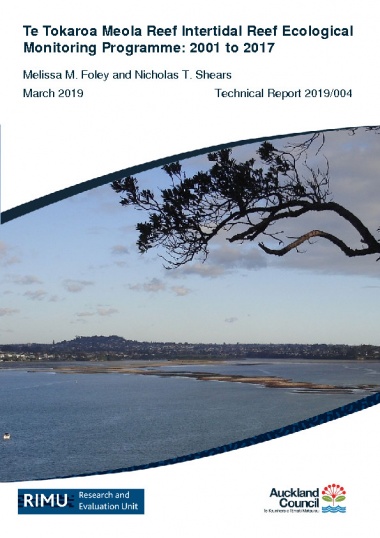Te Tokaroa Meola Reef intertidal reef ecological monitoring programme: 2001 to 2017
Author:
Melissa M Foley, Nicholas T ShearsSource:
Auckland Council Research and Evaluation Unit, RIMUPublication date:
2019Topics:
EnvironmentExecutive summary
Annual ecological surveys have been conducted at six sites on Te Tokaroa Meola Reef since 2001 by Auckland Council and the University of Auckland. At each site, we recorded the abundance of mobile macroinvertebrates, as well as estimated the per cent cover of sessile macroinvertebrates, macroalgae, and substrate type. This reef monitoring contributes to our regional state of the environment monitoring network. This report presents an update on the ecology of the reef and any changes detected in the community since 2001.
Between 2001 and 2017, oysters (Crassostrea gigas and Saccostrea glomerata) were the most abundant species found in our plots. While oysters are a relatively new foundation species for Te Tokaroa Meola Reef, they provide complex habitat for a host of other species. Abundance of oysters started to decline at the most seaward sites in 2012, which corresponded to a marked increase in the abundance of the predatory oyster borer snail (Haustrum scobina).
The abundance of most macroinvertebrate and macroalgae species, as well as the overall community composition of our sites varied significantly in time and space. The abundance of macroinvertebrates was cyclical, with peaks tending to occur during positive phases of the El Niño Southern Oscillation. Community composition at each site started to become less similar around 2011, mainly at sampling sites located farther into the Waitematā Harbour. The community composition at these sites was also more variable over time, and they were less similar to one another than sampling sites closer to the land. The greater variability in these communities is likely a result of dynamic water movement caused by tides and wind-driven waves, as well as their location on the shore with respect to mean low water. We also recorded an increase in sediment at most of our sites between 2001 and 2017, but the increase was most dramatic at sites on the western side of the peninsula.
Because the data are highly variable, it is difficult to detect significant trends in macroinvertebrate and macroalgal abundance over time. With the exception of the oyster borer snail and the red macroalgae Gelidium spp., we have seen sharp declines for most species since 2016. While these changes may be within the range of natural variability in the system, the community is likely being affected by multiple stressors, including increasing sediment deposition, high metal concentrations, and declining water quality in the upper Waitematā Harbour. Continued surveys that extend our long-term data set will allow us to analyse changes in community composition over time and space, as well as identify potential stressors that may be altering environmental conditions and intertidal communities. Continuing this monitoring is also important given the projected climate related changes that are predicted to occur in the Auckland region over the next two generations.
Auckland Council technical report, TR2019/004
March 2019
